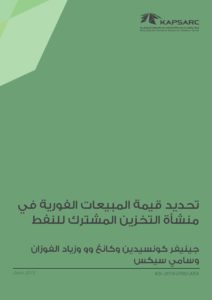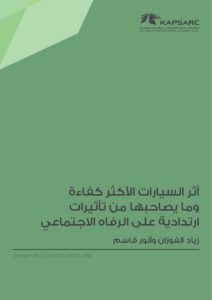يمتلك زياد خبرة في نمذجة الطلب على الطاقة ويركز في عمله على تطوير نماذج الاقتصاد القياسي للمملكة ، ويعمل محلل بحوث أول في مركز الملك عبد الله للدراسات والبحوث البترولية، وهو حاصل على درجة البكالوريوس في الهندسة الصناعية من جامعة الملك سعود
يمتلك زياد خبرة في نمذجة الطلب على الطاقة ويركز في عمله على تطوير نماذج الاقتصاد القياسي للمملكة ، ويعمل محلل بحوث أول في مركز الملك عبد الله للدراسات والبحوث البترولية، وهو حاصل على درجة البكالوريوس في الهندسة الصناعية من جامعة الملك سعود

KAPSARC: The purpose of this paper is to assess Middle East crude oil exporter strategies to maintain or expand market share in Asian oil demand. It also analyses the impact of changing global crude oil flows on key oil exporters’ revenues and on inter-regional price differentials by utilizing the KAPSARC Global Oil Trade Model (GOTM). Oil trade between the Gulf Cooperation Council (GCC) and Northeast Asia (NEA) will be subject to new pressures as major crude oil producers from outside the region compete to place their barrels in Asia. African, Latin American, and Russian flows of crude are increasingly redirected towards Asia, challenging the traditional large exporters in the Middle East. GCC oil producers are engaged in a number of initiatives to protect market shares in Asia. © The Editor(s) (if applicable) and The Author(s) 2016.
1st يناير 2016
يشير التخزين المشترك للنفط المذكور في هذا البحث إلى الترتيبات التجارية التي يتم بموجبها تملك والمتاجرة بالنفط الخام من جانب إحدى الدول المصدرة للنفط، وتخزينه لدى دولة مستوردة مقابل أولوية سحب الدولة المضيفة منه في حالات الطوارئ، ويمكن بالتالي تصنيف هذا التخزين باعتباره تخزيناً تجارياً واستراتيجياً في آن معاً (Doshi and Six 2017)
23rd يناير 2020
تحسين كفاءة استخدام الطاقة في السيارات يجعل قيادتها أقل تكلفة مما يسمح لسائقي السيارات بالقيادة مسافات أطول. تعرف هذه القيادة الإضافية بالتأثير الارتدادي أو الارتداد لأنها تلغي جزءًا من وفورات الطاقة المتوقعة من تحسين كفاءة الطاقة، وغالبًا ما ينظر إليها نظرة سلبية. وتجري هذه الورقة البحثية تحليلاً للتكاليف والفوائد المرتبطة بالتأثير الارتدادي بعد تحسين كفاءة الطاقة في السيارات في مائة بلد.
30th أكتوبر 2017Evidence confirms that there is a positive correlation between the economic growth rate and its volatility/risk in the Gulf Cooperation Council (GCC) region. In other words, there is a trade-off between the benefits of oil and gas activity and the volatility resulting from unpredictable commodity price swings in such resource dependent economies. Our analysis uses a financial portfolio framework approach (and more specifically an efficient frontier analysis), treating economic sectors as individual investments. We calculate a relative risk measure termed the ‘beta coefficient’ and assemble a portfolio of sectors with varying weights to find the efficient frontier. If the beta of the portfolio representing the economy is above global average, the economy will generally grow faster than the global average but with greater volatility – the upturns will be higher and the downturns deeper. We aim to shed light on diversification policy from this novel, if not yet widely accepted, perspective.
8th مارس 2017Trade between the economies of the Gulf Cooperation Council (GCC) and North East Asia (NEA) reached $471 billion in 2013, based almost entirely on oil and gas. The GCC sends 44 percent of its exports to NEA, which depends on the GCC region for a very high proportion of its oil imports. Trade relations are otherwise very limited: the GCC takes only 3 percent of NEA’s exports.
8th أغسطس 2016It is popularly believed that importers of oil diversify their suppliers to achieve security of supply and that exporters diversify their customer base to achieve security of demand. However, this diversification comes at a cost, compared with buying from or selling to the most economically attractive counterparties— analogous to paying an insurance premium. In fact, our research suggests that this illustration may not properly describe the outcomes for large individual producers or consumers (or coalitions of these) and that diversification can also be a strategy for revenue maximization or cost minimization. We have developed KAPSARC’s Global Oil Trade Model (GOTM), which is calibrated to the configuration of the global oil markets in 2012, to demonstrate our framework. Our model shows that, in 2012, the volumes of supply and demand and the trade flows constrain the valid candidates to combine diversification with economic gain. Only the trading pair of the Arabian Gulf exporters and North East Asian importers can benefit. This is the illustration that we develop in this paper. However, a future reconfiguration of crude flows—perhaps with growth in North American exports to the Pacific or a major pivot by Russia to sell material volumes to China and other North East Asian customers—could introduce new players. KAPSARC’s framework may prove valuable to understanding potential future dislocations in crude oil trade flows.
6th أغسطس 2015